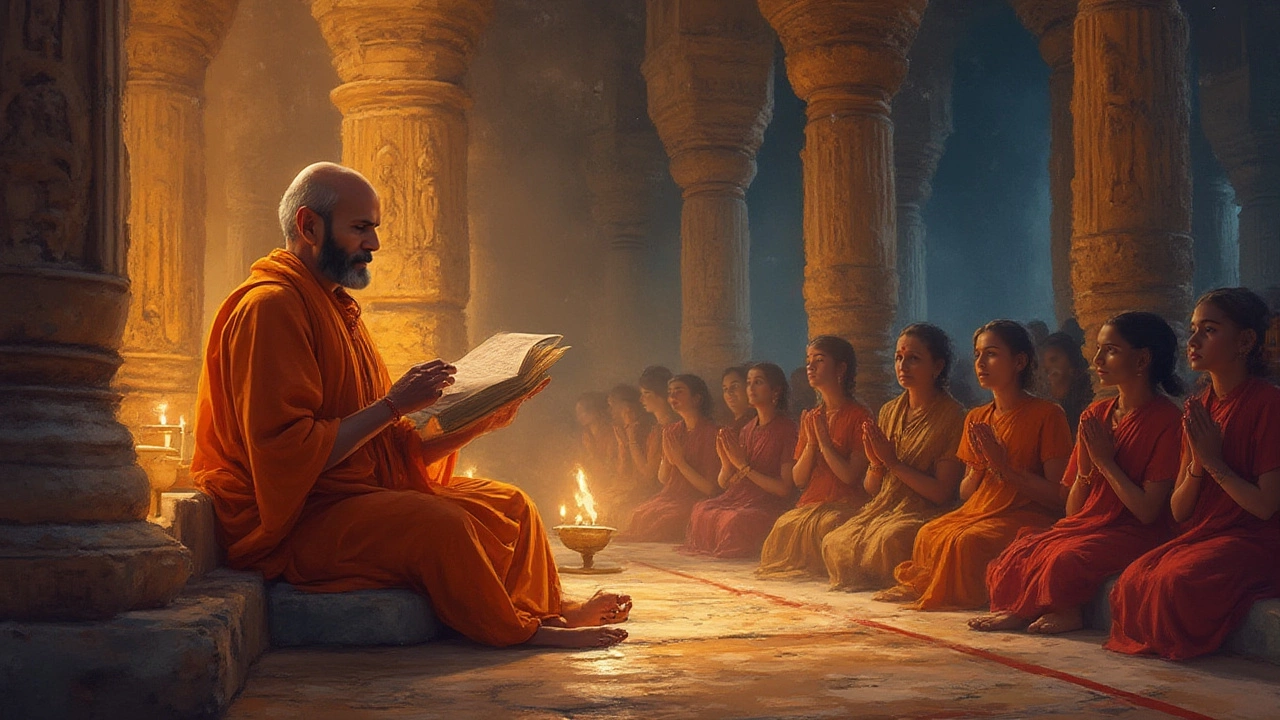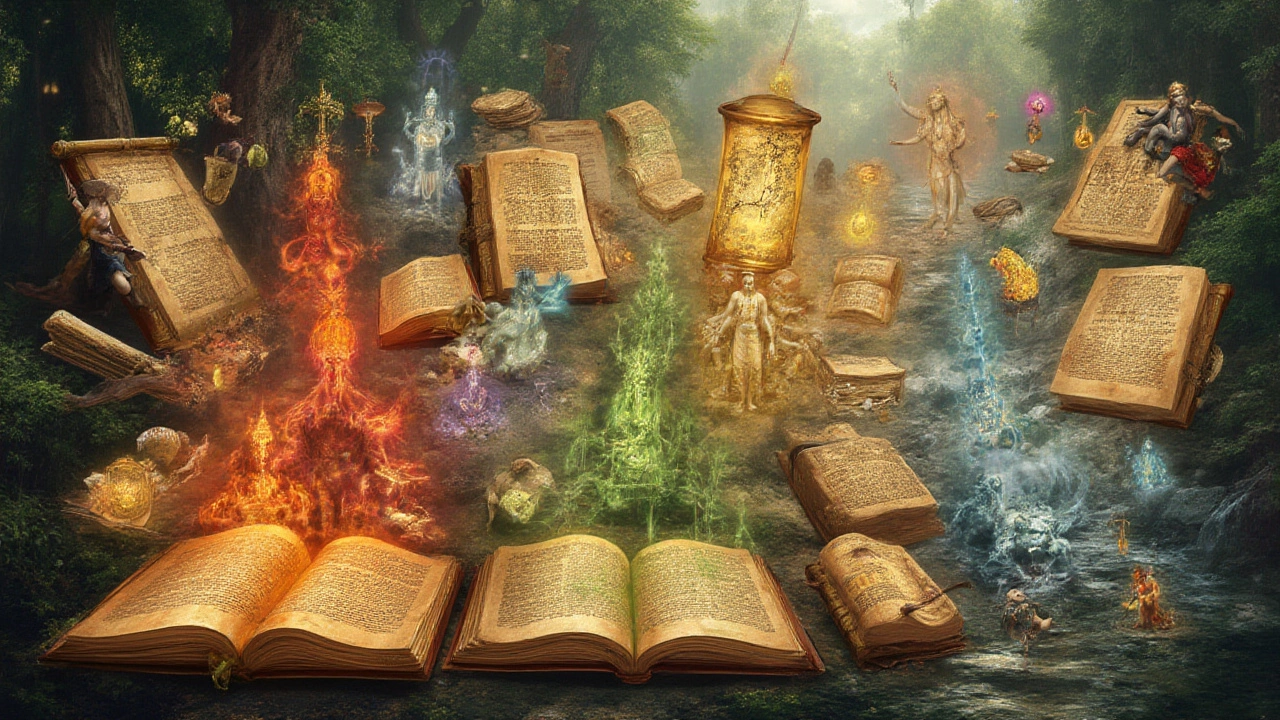The idea of a single, definitive holy book—like the Bible for Christians or the Quran for Muslims—feels like a universal religious standard. But here’s the twist: Hinduism, with more than 1.2 billion followers, doesn’t box its beliefs into one sacred text. This surprises a lot of folks used to religions with “the book.” If you’ve ever wondered, “Do Hindus have a Bible?” you’re not alone. The question cuts straight to the heart of how Hinduism works—it’s not just about gods and rituals, but a totally different way of thinking about spiritual authority. It’s kind of wild when you dig into it.
Why There’s No ‘Hindu Bible’
Let’s put it out there: There isn’t a single book called the “Hindu Bible.” Instead, Hinduism bursts at the seams with scriptures—massive, ancient, poetic, and sometimes pretty mysterious. Before we go any deeper, let’s bust a myth. People sometimes call the Bhagavad Gita, the Vedas, or the Upanishads the “Hindu Bible.” That’s not how Hindus think about it. Each of these texts holds a different spot in the tradition. The real story: Hinduism is a living river of texts, not a single book on a shelf.
If you check the timeline, the Vedas (the oldest) go back as far as 1500 BCE. They’re not just one book but a whole family of texts: Rigveda, Samaveda, Yajurveda, and Atharvaveda. No one’s actually sure who “wrote” them—they’re considered heard or revealed, the word is śruti. These alone run to thousands of pages if you try to print them out. Then come the Upanishads, the Ramayana, the Mahabharata (about ten times the length of the Iliad and Odyssey put together!), and the Puranas. The Bhagavad Gita? It’s a 700-verse chapter in the Mahabharata. So if you want to think in “Bible” terms, picture a library—one with books of poetry, songs, philosophy, stories, and advice, all swirling together.
This makes sense once you remember that Hinduism doesn’t have a single founder or a single council that set out “the book.” The religion grew up over thousands of years, with different schools of philosophy, local gods, and changing traditions. Imagine a living tree: roots everywhere, branches always splitting and growing. You can travel to Varanasi and hear a priest recite the Gita, but someone else in Kerala may chant the Lalita Sahasranama, while a Tamil grandmother reads hymns about Murugan. Nobody is out there on the street with a one-size-fits-all book saying, “Read this and you’re Hindu.”
One more thing: Not every Hindu reads the texts. For millions of families, traditions flow through rituals and festivals handed down by elders, not just through books. Written scriptures are honored, but day-to-day, it’s living customs that shape belief for most folks.

The Big Texts: What Do Hindus Read?
So, what are the books that shape Hindu beliefs? Let’s break down the most important groups. For starters, you’ll often hear two categories: śruti (what is heard) and smṛti (what is remembered).
- Vedas: The Vedas are the granddaddies. They come first and are called śruti, which means the divine origin. The Rigveda is made up of hymns to ancient gods—think Agni, Indra, Varuna. The Samaveda translates these into songs. Yajurveda gives you mantras for rituals. Atharvaveda deals with healing, folk customs, and chants.
- Upanishads: Want philosophy? The Upanishads turn rituals into discussions about the soul (atman), existence, and reality. They’re less “here’s how to sacrifice a goat” and more “what is the meaning of life?”
- Itihasas: The big stories—the Ramayana and Mahabharata. The Ramayana tells the story of Prince Rama and the demon king Ravana (you’ve seen those Diwali fireworks, right?). The Mahabharata is an epic about war, cousins, cosmic battles, and morals—inside it sits the Gita, where Krishna gets deep and tells Arjuna to do his duty.
- Puranas: Stories of gods and creation, packed with legends, gods, genealogies of kings, how the world will end, and why Ganesha has an elephant’s head. With 18 major and 18 minor Puranas, it’s basically Netflix for Hindu mythology.
- Agamas and Tantras: Not as famous worldwide, but totally key in temple rituals, especially in South India or among Shaivites and Shaktas. These texts describe everything from building temples and idols to practicing yoga and worshipping the goddess (Devi).
Lots of families focus on a single text. For example, devotees of Krishna might recite the Bhagavata Purana. Shiva devotees turn to the Shiva Purana. So, in a way, your “bible” might depend on your family deity. Some homes have the Ramcharitmanas—a 16th-century Hindi retelling of the Ramayana—on the altar instead of the original Sanskrit version. Go to Bengal, you’ll find homes with the Chandi Path or Gita.
Here’s the interesting part: these scriptures are way more than just rules. They mix myth with philosophy, stories with rituals, law codes with spiritual insight. If you read through the Mahabharata, you’ll get love, betrayal, super-powers, divine weapons, and deep, almost existential questions about duty. Do the Vedas prescribe rituals? Yes. Do the Upanishads care more about inner realization? Exactly.
Now, textbooks sometimes say the Bhagavad Gita is “the Hindu Bible.” It’s a bit misleading. The Gita certainly punches above its weight, especially after Mahatma Gandhi called it his “spiritual dictionary,” but most Hindus see it as one part of a much bigger story—powerful, but not the whole deal.
Let’s look at some numbers in an easy format:
| Text | Estimated Verses | Main Focus |
|---|---|---|
| Rigveda | 10,552 | Hymns, Rituals |
| Yajurveda | 1,975 (Black), 1,875 (White) | Ritual Formulae |
| Mahabharata | 100,000+ | Epic Story, Philosophy |
| Ramayana | 24,000 | Epic Story, Morality |
| Bhagavad Gita | 700 | Philosophy, Ethics |
| Bhagavata Purana | 18,000 | Devotion (Bhakti) |
| Shiva Purana | 24,000 | God Stories, Rituals |
That’s a lot of reading material. Nobody has read it all. Most Hindus hear snippets in temples, at home, on TV, or through songs. The oral tradition is alive and kicking—priests chant verses, parents tell stories, and festivals bring old legends to life.

Tips for Navigating Hindu Scriptures
So, if you’re curious about getting a taste of Hindu sacred literature, where do you start? This stuff isn’t always easy to crack, but it’s way more approachable than it looks from a distance. Here’s what works, whether you’re a student, a traveler, or just curious about the world:
- Don’t look for a single book. Hinduism isn’t about “the one book.” Come in expecting a library, not a pamphlet.
- Start with the Bhagavad Gita for Philosophy. It’s short (700 verses), packed with questions about duty, good, evil, and life purpose. Loads of English translations exist, from scholarly (Swami Prabhupada, Eknath Easwaran) to poetic.
- Read stories from the Ramayana and Mahabharata. These feel like ancient Marvel comics—heroes, monsters, battles, drama.
- Watch or listen first. India has a televised Ramayana and Mahabharata. YouTube is flooded with bhajans (devotional songs) and storytelling festivals like Kathakali or Ramleela plays.
- Ask locals what they read or recite—people love to share, and every region has favorites.
- Look for regional languages. Many texts exist in Hindi, Bengali, Tamil, Telugu, Malayalam, and more. In fact, family altars might have a copy in the local language, not Sanskrit.
What might shock you is just how much the texts shape everyday life—even if nobody’s reading the Sanskrit verses. Birth ceremonies, weddings, housewarmings, even how you light lamps at sunset: all borrow from the old books. You’ll see priests recite verses for a marriage in Delhi, while a grandmother in Maharashtra explains why certain foods are eaten during a festival by quoting a story from the Puranas.
Hinduism is famously flexible. There’s room for doubters, for mystics, for ritualists and storytellers. Some folks see Krishna as their guiding guru and dive into the Bhagavatam. Others are drawn to the calm wisdom of the Upanishads, or find meaning in the fiery hymns of the Devi Mahatmyam.
If you talk to Hindu scholars or everyday believers, you’ll find out something else: interpretation is right at the heart of it. Each school, each tradition, each temple might focus on different verses, different ways of chanting, even different explanations for the same line. This is actually encouraged—“truth is one, sages call it by many names” (Rigveda 1.164.46) is a real line from the oldest text.
By now, you probably get why there’s not one single “Hindu Bible.” Hindu sacred texts are more like a vast web, connecting different eras, ideas, aspirations, and questions—never just black-and-white laws or a static creed. If you’re expecting a shortlist, you’ll end up with a bookshelf instead. But that’s the magic: no one is boxed in, and the quest for meaning never hits a final page.
